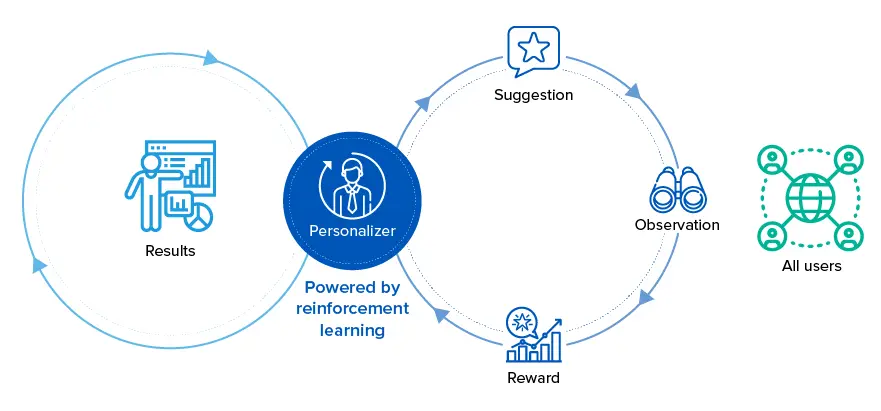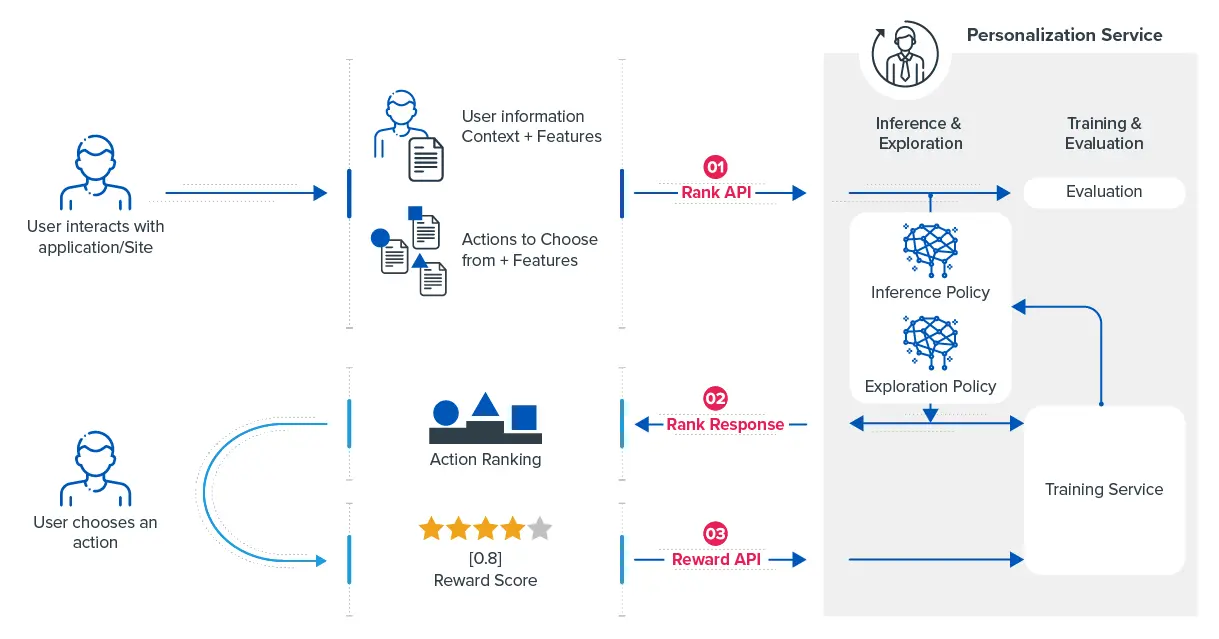The future of the digital experience is personalization. Microsoft's API service, Azure Personalizer, allows you to utilize the power of your customer data to increase engagement, loyalty and advocacy. This article explains how.
Introduction
Ever heard about the “Netflix Prize”? On October 2, 2006, Netflix announced this open competition for the best algorithm to predict user ratings for films and the winner stood to received $1,000,000! The mission was to make the company's recommendation engine (Cinematch Algorithm) 10% more accurate. Why would the world’s leading internet entertainment service ever open up the the public for help with their product and pay so much for it? The simplest answer is innovation. Discovering better, fresher, and impactful solutions.
The Advent of Azure Personalizer
According to HubSpot, 74% of online consumers get frustrated with websites that display content, which has nothing to do with their interests. Also, HubSpot found that personalized CTAs (Calls to Actions) had a 43% higher view-to-submission rate than CTAs that were the same for each visitor. With the rise of streaming platforms like YouTube, Netflix, and Spotify and the continued growth of e-commerce, the number of options (movies, music, books, products, etc.) available to consumers became overwhelming. Delivering relevant, personalized, interesting and intelligent experiences to users gained more momentum.
The stumbling block here is that it involves building models based on data that sits in a variety of silos and requires a robust cloud platform, the right technical expertise, and modern development tools. Here’s where the Azure Personalizer comes into play. Personalizer is Microsoft’s API service that doesn’t need the kind of training data typically used in machine learning. Instead, it constantly tries to find the best way to achieve a given goal based on user behaviour and prioritizes relevant content for each user. Apps and websites can now leverage the power of data and boost user engagement with personalized features and services.
“We are able to take reinforcement learning and ship it in a way that’s accessible to developers and doesn't require a data scientist.” -Lance Olson (Director of Program Management for Applied AI, Microsoft)
With the launch of Personalizer, the Holy Grail for personalized experiences, Microsoft aims to democratize real-world, reinforcement learning for context personalization. With the Personalizer API, Microsoft saw a 40% lift in user engagement on the Xbox home screen.
What is Azure Personalizer?
Azure Personalizer is a cloud-based API service that helps developers create rich, personalized experiences for each user of your app. The API provides a user-friendly interface and enables developers to prioritize content and tailor experiences to improve user engagement.

Personalizer comes under the Decision Suite (a new addition to Azure Cognitive Services) and uses Microsoft's reinforcement learning - an artificial intelligence-based technology that learns from user-app interactions. As the user interaction with the app increases, so does the effectiveness of the Personalizer API in delivering tailored responses to the user.
How does the Personalizer work?
Personalizer decides the best action (content to serve up) based on collective behavior and reward scores (typically a value between 0 and 1, such as 1 for positive, and 0 for negative, or any value that matches the business goals and metrics) across all users. Data sent to the API, along with the Rank and Reward calls is used exclusively to train the model and attain higher accuracy.

Using the movie-streaming platform example, this is how it works:
- Actions, with features, are sent to the Personalizer. Features include both the action feature (metadata about the content) and the context feature (metadata about the context in which the content is presented) used to personalize content. The Rank API decides to either exploit the present model (decide the best action based on past data) or explore (select a different action rather than the top action). In our use case, the actions are a set of movies and features like genre, actors, ratings, etc. Personalizer can either choose a recommendation based on the past user preference (favourite genre, actor/actress, etc) or suggest a random movie (maybe, the top trending movie).
- The top rank content is returned. The application displays that content to the user and determines a reward score based on the business rules. The application returns the score to the learning loop. In the movie recommendation scenario, the score can be based on whether the user watched the recommended movie till the end or discontinued it after viewing for a few minutes.
- The Reward API collects data to coach the model using the features and reward scores of each rank call and uses that data to update the model.
Recommendation Engines vs. Personalizer
Both recommendation engine and Personalizer are often utilized in tandem by taking the output of a recommendation engine (for example, the top 20 items for a user) and use that as the input actions for Personalizer. But there are some key differences between the two:
- A recommendation engine collects many items and recommends a subset from it. For example, it might recommend 20 items from an input of 50,000 items. Personalizer, however, takes a couple of actions with lots of information about them and ranks them in real-time for a given rich context.
- Most recommendation engines are based on the metadata collected from a user’s history and interactions. On the contrary, Personalizer has no dependency on prior historically labelled data.
- Personalizer Service has this notion of exploitation and exploration. It might exploit the existing ML model and recommend an item based on past data or use an alternate approach based on the Epsilon Greedy algorithm, to explore a different recommendation item. Designed to autonomously explore user preferences over time, it can yield better results even when the content changes rapidly, like news, live events, etc.
Why Should You Use Personalizer?
Better user experiences with real-time learning.
Personalization is all about considering the diversity between people. It’s about offering each of your customers, a unique experience so that they begin to feel known and understood. This subsequently encourages them to spend more time on your site/app, trust your brand, and become more engaged. The key to achieving this is supplying relevant and personalized content that improves over time, based on their behaviour/real-time feedback.
Better business results and productivity.
Personalizer allows organizations to develop better content, deepen the connection with their target audience, and ultimately achieve greater ROI. Without relevant content, potential customers may divert to a competitor who’s content is better tailored to their needs. By knowing what a user wants, companies gain a competitive advantage and reduce the threat of losing a customer.
Where to Use Personalizer?
Personalizer features a plethora of applications. Basically every use case where a ranking of options is sensible and not limited to a simple static list of things to be ranked. Personalizer coupled with other cognitive services can be leveraged to create better outcomes. By pre-processing your items using other cognitive services, you can automatically extract information that is likely to be relevant for personalization.
Some of the use-cases for Azure Personalizer are:
- Content highlighting and filtering
- UI usability improvements
- Default suggestions for menus & options
- Intent clarification
- Improving bot traits and tone
- Notification content & timing
- Contextual decision scenarios
The Future
The rising trend towards improved customer experience (CX) is going to be an enormous driving factor in the way applications evolve within the foreseeable future. With the massive potential to create more targeted, contextually relevant, and personal user experiences, Azure Personalizer will revolutionize customer experiences.
Need help personalizing your customer experience? Valorem specializes in building personalized and innovative customer experiences. Reach out to us at marketing@valorem.com to learn more about our Customer Experience solutions.



